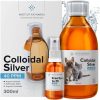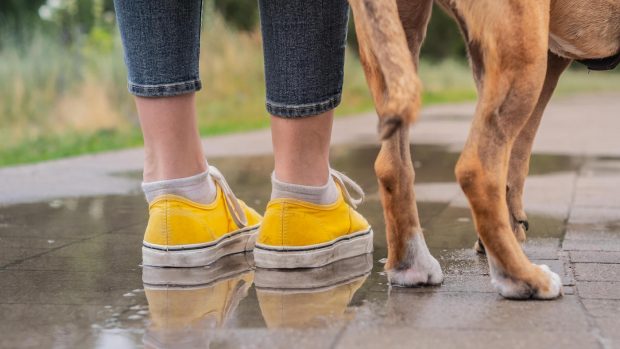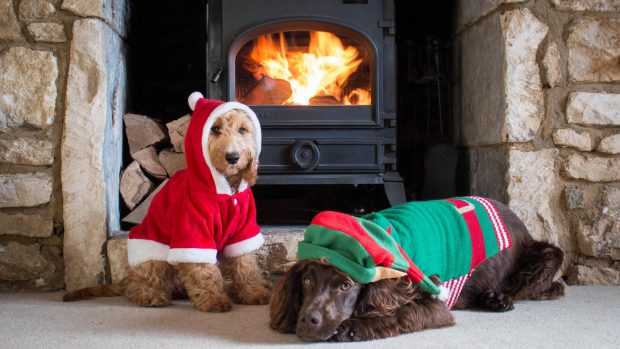When you’re wondering how to stop a dog licking a wound, the first thing to establish is why they are licking. If your dog has a known wound or has had surgery, you’ll want to keep the area clean to prevent infection or any further complications. There may, however, be a problem that you can’t see – for example, a dog with a grass seed in his foot will be extremely irritated, but you may not be able to see it with the naked eye. They will keep licking until you see a red lump and that presents usually as an interdigital cyst, which will need veterinary intervention. Treating a wound and bandaging it with a self-adhesive bandage (like this one on Amazon) usually rectifies the licking, but some dogs will move on to biting at the bandage. If the wound is on the foot, you can also try a pair of the best shoes for dogs to keep the feet covered.
The traditional solution for the problem of how to stop a dog licking a wound is the plastic cone collar (like this one on Amazon), which is commonly referred to as the “cone of shame”. These can be cumbersome, however, and have the potential to become very sweaty, which then adds sweaty ears, infection and sores around the neck to your list of problems. A softer cone (like this one on Amazon) or inflatable neck collar (like this one on Amazon) is usually preferable where possible as they are more comfortable and they bend, but not enough for your dog to get at the injured area.

All Four Paws Comfy Cone | Amazon.co.uk
This soft, cone collar is made with foam-backed, padded nylon that is easy to clean and is water-resistant and repellent. It fastens with Velcro, is reversible and can be worn around the head or shoulders and chest.

Inflatable Neck Collar | Amazon.co.uk
This collar can be attached to your pet’s normal collar for extra security. It has a removable and washable cover, and can be deflated for storing.

Recovery Cone Collar | Amazon.co.uk
This effective cone prevents your dog from touching or licking wounds or injuries, while ensuring their comfort when eating, drinking, sleeping or playing.
Why do dogs lick wounds?
Like many other animals, including horses, cats, rodents and primates, it’s an instinct for dogs to lick their wounds as a means of cleaning themselves by removing dirt and hair. Saliva also has enzymes that can kill some harmful bacteria, such as E. coli, but not all.
Flushing the wound through with saline water is more beneficial and it is not always wise to let a dog continue to lick a wound as it can become harmful, break down the skin and slow the healing process as it can introduce more harmful infections.
Licking is also a way for a dog to soothe pain – for example, my eldest English Mastiff, Mavis, suffers with arthritis in her feet and wrist and quite often I know she’s suffering due to the licking. I can then make her more comfortable and stop the licking before it becomes damaging.
How to stop a dog licking a wound
Despite it being natural and instinctive, it’s best not to let your dog lick his wound – especially not in the long term, as it will provide a warm and wet area for more bacteria to breed. Veterinary wound management and remedies over the counter are much more helpful when it comes to treating the wound, and some of these also taste disgusting to your dog, which acts as a great deterrent.
Once you’ve cleaned and treated the wound – or it’s been treated by a vet if necessary – and it’s been suitably covered, using a soft cone or collar is the best way to prevent your dog from accessing it.
If a dog has had surgery, as the healing progresses the area can become itchy and the dog may want to lick the wound. In this case, there are some great body suits (like this one on Amazon), which prevent your dog from accessing the wound, but are also useful for dogs with allergies to grass.

Hibiscrub | Amazon.co.uk
This antimicrobial and antibacterial skin cleanser helps to prevent infections by killing germs on the skin.

Battles Veterinary Wound Powder | Amazon.co.uk
Useful for minor wounds, cuts, bites and scratches, this white wound powder is absorbent and antibacterial, which creates a good environment for healing.

PetSol Styptic Powder | Amazon.co.uk
This powder stops small wounds from bleeding, acts as an anti-inflammatory and helps to sterilise wounds so that your pet will heal better without the risk of infection.

Activon Manuka Honey | Amazon.co.uk
This medical grade manuka honey is antibacterial and supports wound healing. It draws fluid from the wound bed, promotes autolytic debridement and inhibits bacterial growth.

Dog Recovery Suit | Amazon.co.uk
This comfortable recovery suit gives your dog great freedom of movement while preventing pets from licking wounds and biting bandages.
How to tell if a dog’s wound is infected
The following signs suggest a wound is infected:
- Redness, irritation and swelling
- Pus coming from the site
- Foul smell leading to necrosis
- It’s causing increasing pain or pressure
- The wound is hot and taking a long time to heal
- Your dog has a temperature and is lethargic
When should a wound be seen by a vet
- The wound is bleeding heavily and will not stop
- There is a visible foreign body, such as a nail or glass
- The wound is large and/or in or around the eyes, face or head
- The dog was bitten by another animal
- It was caused by trauma, such as a car accident or impaling themselves
You might also be interested in:

Booties to protect your dog’s paws against frost, flints and burning tarmac

Don’t scratch that itch! Best products to relieve your dog’s irritated skin

How to stop your dog chewing your home to shreds

6 of the best puzzle toys to boost your dog’s IQ (and keep him out of mischief)

How to help a teething puppy

Equine first-aid kit essentials: what you really need
If you're unsure about what you should have in your horse’s first-aid kit, then we are here to help...

Subscribe to Horse & Hound magazine today – and enjoy unlimited website access all year round
Horse & Hound magazine, out every Thursday, is packed with all the latest news and reports, as well as interviews, specials, nostalgia, vet and training advice. Find how you can enjoy the magazine delivered to your door every week, plus options to upgrade your subscription to access our online service that brings you breaking news and reports as well as other benefits.





